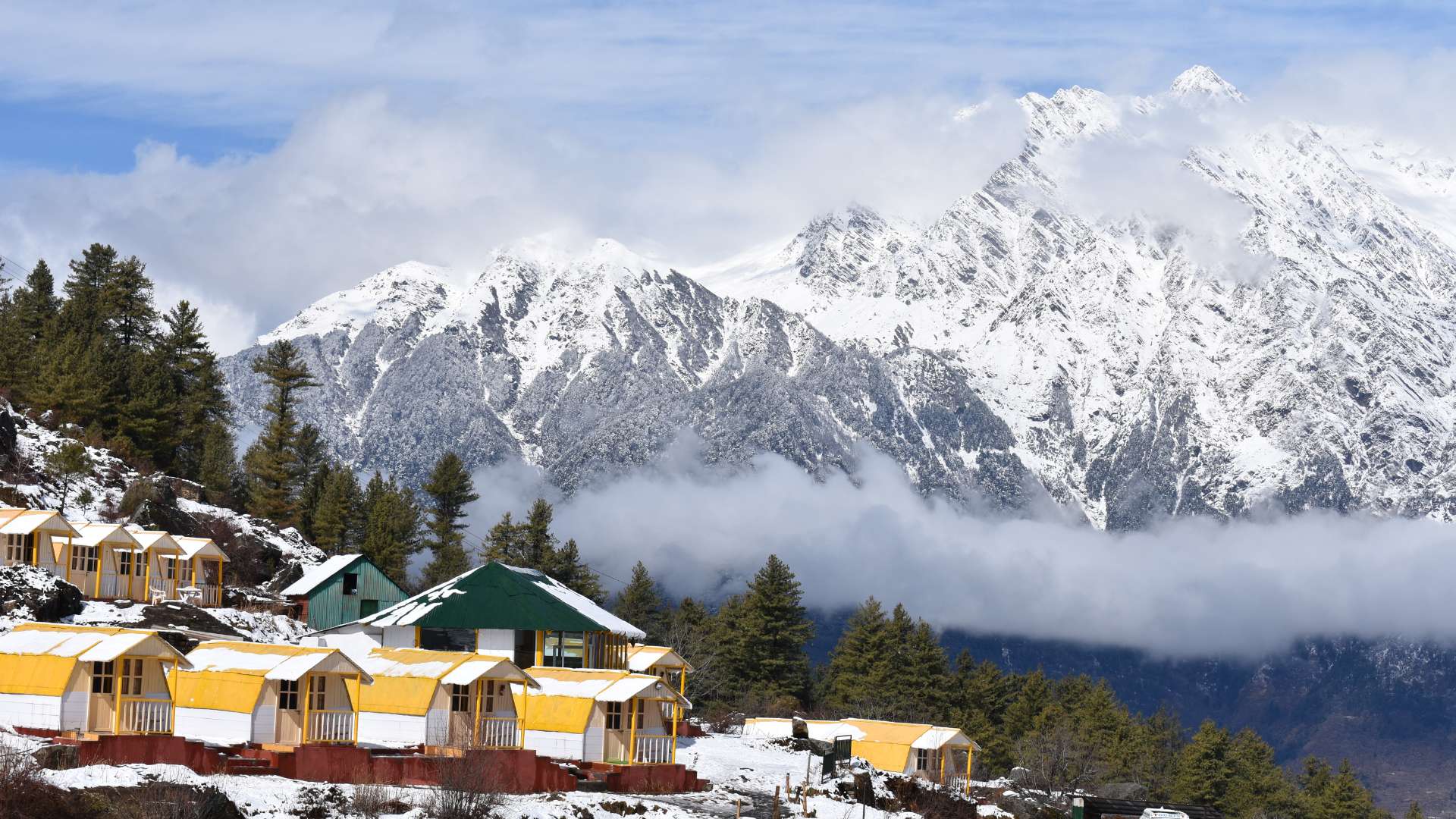Table of Contents
ToggleMadhya Pradesh, often referred to as the “Heart of India,” boasts a rich cultural tapestry that is reflected in its traditional attire.
The state’s diverse communities, from tribal groups to royal dynasties, have contributed to a vibrant collection of dresses both Males and Females wear.
These traditional garments, from the intricate Lehenga-Choli and elegant Chanderi sarees to the timeless Dhoti and dignified Safa, represent more than just clothing—they tell the stories of heritage, pride, and craftsmanship.
Each dress is carefully crafted using regional fabrics, adorned with intricate patterns, and often reserved for significant cultural events such as weddings, festivals, and religious ceremonies.
Exploring the traditional attire of Madhya Pradesh offers a window into the state’s historical and cultural richness.
What Makes the Traditional Attire of Madhya Pradesh Unique?
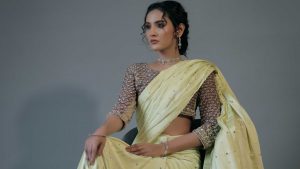
Madhya Pradesh’s traditional attire stands out due to its vibrant colors, intricate designs, and the cultural significance embedded in each garment.
The dresses, such as the Chanderi and Maheshwari sarees, are crafted from locally sourced fabrics and reflect the artistic traditions of the state’s weavers.
Similarly, men’s attire like the Dhoti and Safa mirrors simplicity, pride, and functionality. What makes these garments unique is the blend of tribal influences and royal heritage, with each region contributing its own distinctive style.
These outfits are not just about fashion but are tied to cultural identity, worn proudly during festivals, weddings, and religious ceremonies, preserving the age-old traditions of Madhya Pradesh.
How Does the Climate of Madhya Pradesh Influence Its Traditional Clothing?
The climate of Madhya Pradesh, characterized by hot summers and mild winters, plays a significant role in the selection of traditional fabrics.
Lightweight cotton is commonly used for garments like Lehenga-Choli and Dhoti, making them ideal for the summer heat.
On the other hand, heavier fabrics like silk and wool are preferred in the cooler months, especially in attires such as Mirzai, Bandi, and Maheshwari sarees.
The breathable, handwoven fabrics help keep the wearer comfortable while maintaining the elegant style of traditional dresses.
Seasonal adaptability ensures that these garments remain functional throughout the year, without compromising on their cultural importance or aesthetic appeal.
How Do Festivals and Cultural Events Impact Traditional Clothing in Madhya Pradesh?
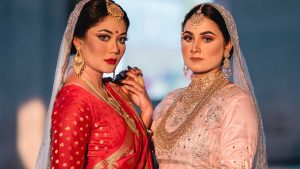
Festivals and cultural events in Madhya Pradesh deeply influence the traditional clothing choices of its people.
During celebrations like Navratri, Diwali, and weddings, vibrant and intricately designed garments such as Lehenga-Choli for women and Safa paired with Dhoti for men are commonly worn.
These occasions are opportunities to showcase the state’s rich textile craftsmanship, with intricate embroidery, zari work, and mirror embellishments taking center stage.
Traditional attire during festivals is not only about aesthetic appeal but also reflects cultural pride and continuity. Each festival brings out specific outfits tied to rituals, making clothing an essential part of the celebration itself.
What Role Do Regional Variations Play in the Traditional Attire of Madhya Pradesh?
Regional variations play a key role in shaping the traditional attire of Madhya Pradesh. Each area, from Malwa to Bundelkhand, has its own distinctive style and preferences when it comes to clothing.
For example, the Chanderi sarees from the town of Chanderi are known for their lightweight fabric and intricate motifs, while the Maheshwari sarees from Maheshwar blend silk and cotton for a more luxurious look.
Similarly, tribal communities like the Bhils and Gonds wear the Lugda, a simpler draped garment with earthy tones and natural motifs.
These regional differences highlight the cultural diversity of Madhya Pradesh while contributing to its collective identity.
How Has Modernization Influenced Traditional Attire in Madhya Pradesh?

Modernization has certainly influenced traditional attire in Madhya Pradesh, but rather than diminishing its appeal, it has led to adaptations that blend tradition with contemporary trends.
While many people now wear Western outfits for everyday use, traditional garments like Chanderi and Maheshwari sarees, as well as Angarkha and Safa for men, are still cherished during special occasions.
Designers have introduced modern cuts, lighter fabrics, and new color schemes to make these traditional outfits more versatile and accessible to a wider audience.
Despite these modern tweaks, the essence of Madhya Pradesh’s cultural heritage remains intact, allowing the traditional attire to evolve while preserving its significance.
Why is Craftsmanship Important in Madhya Pradesh’s Traditional Clothing?
Craftsmanship is the backbone of Madhya Pradesh’s traditional clothing, with a long history of handloom weaving and intricate embroidery.
Skilled artisans from the state produce garments that are not only beautiful but also representative of cultural heritage.
For instance, Chanderi and Maheshwari sarees are known for their delicate handwoven patterns, often using gold or silver threads, reflecting royal patronage.
Craftsmanship also plays a key role in the durability and quality of these garments, making them highly sought after for festivals and weddings.
This artisanal skill has been passed down through generations, ensuring that each piece of clothing carries the legacy and pride of Madhya Pradesh’s rich textile tradition.
Top 10 Madhya Pradesh Dress for Male & Female
1. Lehenga-Choli – A Vibrant Traditional Attire
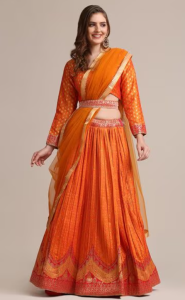
Image – Source
The Lehenga-Choli is a quintessential attire worn by women in Madhya Pradesh, especially during festivals and weddings.
This vibrant ensemble consists of a long skirt (Lehenga) paired with a fitted blouse (Choli) and an Odhni (a long scarf).
The bold use of colors like red, green, and yellow adds to its cultural significance, making it popular across Malwa and Bundelkhand regions.
Intricate embroidery, mirror work, and zari embellishments often adorn these garments, giving them a rich and festive look.
The Lehenga-Choli is commonly worn during events like Navratri, symbolizing grace, beauty, and cultural pride in the region. Its adaptability and elaborate designs make it a beloved traditional outfit among women of all ages.
Lehenga-Choli Dress Details
| Dress Feature | Details (Female) |
| Dress Name | Lehenga-Choli |
| Primary Fabrics | Handwoven cotton, Chanderi silk, Maheshwari fabrics |
| Regional Variations | Worn by various communities in Malwa, Bundelkhand, and tribal areas like Baiga and Bhil |
| Typical Colors | Bright shades like red, green, yellow; often paired with contrasting cholis |
| Ornamentation | Intricate embroidery, mirror work, and zari embellishments |
| Special Occasions | Commonly worn during weddings, festivals like Navratri, and cultural celebrations |
| Jewelry & Accessories | Paired with silver jewelry, bangles, payal, and nose rings for an elegant look |
| Cultural Symbolism | Represents feminine beauty, prosperity, and cultural heritage |
| Seasonal Adaptation | Cotton lehengas for summer; heavier silk and woolen fabrics for winter |
| Craftsmanship | Known for handloom techniques and artisanal craftsmanship from local weavers |
| Influence of Royalty | Influenced by royal families who patronized traditional textiles and designs |
| Modern Adaptations | Lehengas have evolved with modern cuts, fusion styles, and use of different fabrics for various occasions |
| Functionality | Offers freedom of movement and is often more comfortable for traditional dance performances and day-long wear |
2. Bandhani Saree – The Art of Tie-Dye
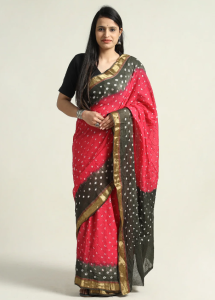
Image – Source
The Bandhani saree is an iconic traditional attire known for its vibrant tie-dye patterns.
Originating from various regions of Madhya Pradesh, this saree uses a distinctive process where the fabric is tied and then dyed to create beautiful, intricate designs.
Bold colors like red and black are often used, making it a stunning outfit for festivals and celebrations.
Popular among women in Bundelkhand and Nimar, Bandhani sarees carry a sense of cultural pride. They are lightweight and suitable for all seasons, while their unique patterns give them a timeless charm.
The meticulous craftsmanship involved makes each Bandhani saree unique and reflective of Madhya Pradesh’s rich textile heritage.
Bandhani Saree Dress Details
| Dress Feature | Details (Female) |
| Dress Name | Bandhani Saree |
| Primary Fabrics | Cotton, silk |
| Regional Variations | Popular in Bundelkhand and Nimar |
| Typical Colors | Bold colors like red, black, and yellow |
| Ornamentation | Tie-dye patterns, intricate designs |
| Special Occasions | Festive wear, especially during cultural celebrations |
| Jewelry & Accessories | Paired with traditional silver jewelry, bangles, and nose rings |
| Cultural Symbolism | Represents cultural identity and heritage |
| Seasonal Adaptation | Lightweight for summer; silk variations for cooler months |
| Craftsmanship | Created using the tie-dye technique passed down through generations |
| Influence of Royalty | Some designs influenced by the royal patronage of traditional crafts |
| Modern Adaptations | Continues to evolve with modern patterns and color combinations |
| Functionality | Easy to drape, comfortable for both casual and festive occasions |
3. Chanderi Saree – A World-Renowned Handloom

Image – Source
The Chanderi Saree from the town of Chanderi is renowned globally for its lightweight fabric and elegant patterns.
Made from a blend of silk and cotton, these sarees are known for their fine weaving and lustrous finish. The distinct motifs of flora, birds, and geometric designs set these sarees apart.
The fabric is ideal for summer, making it a comfortable yet elegant option for festive and formal events.
Chanderi sarees, with their roots deep in history, are symbolic of Madhya Pradesh’s rich textile tradition and craftsmanship, with women across the world appreciating their subtle beauty.
Chanderi Saree Dress Details
| Dress Feature | Details (Female) |
| Dress Name | Chanderi Saree |
| Primary Fabrics | Silk-cotton blend |
| Regional Variations | Predominantly from Chanderi |
| Typical Colors | Soft pastels and rich shades of gold, cream, pink |
| Ornamentation | Motifs of flora, birds, and geometric patterns |
| Special Occasions | Worn during weddings, formal gatherings, and religious events |
| Jewelry & Accessories | Paired with traditional gold jewelry and Kundan sets |
| Cultural Symbolism | Represents royal elegance and artisanal brilliance |
| Seasonal Adaptation | Lightweight fabric ideal for warmer climates |
| Craftsmanship | Known for its fine weaving technique |
| Influence of Royalty | Patronized by royal families |
| Modern Adaptations | Contemporary designs have incorporated modern motifs and color schemes |
| Functionality | Light and comfortable, perfect for day-long wear |
4. Maheshwari Saree – A Blend of Cotton and Silk
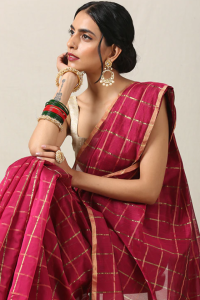
Image – Source
The Maheshwari Saree is another iconic handwoven textile from Madhya Pradesh, originating from the town of Maheshwar.
It is characterized by its lightweight fabric and rich, elegant borders with geometric designs. Crafted from a unique blend of cotton and silk, this saree is known for its durability and comfort.
The intricate weaving patterns, often using zari (gold thread), add a royal touch to this saree, making it a favorite for both festive and formal occasions.
Women across India wear Maheshwari sarees during cultural events, weddings, and religious ceremonies.
The light fabric is ideal for warmer weather, and its simplicity paired with a sense of opulence makes it a timeless piece.
Maheshwari sarees also symbolize the rich textile traditions of the state, with their fine craftsmanship admired worldwide.
Maheshwari Saree Dress Details
| Dress Feature | Details (Female) |
| Dress Name | Maheshwari Saree |
| Primary Fabrics | Cotton-silk blend |
| Regional Variations | Originates from Maheshwar |
| Typical Colors | Earthy shades like maroon, green, and purple |
| Ornamentation | Geometric patterns, zari work on borders |
| Special Occasions | Popular for weddings, religious festivals, and formal gatherings |
| Jewelry & Accessories | Paired with traditional gold jewelry, jhumkas, and bangles |
| Cultural Symbolism | Represents elegance, heritage, and fine craftsmanship |
| Seasonal Adaptation | Suitable for warm climates due to its light fabric |
| Craftsmanship | Handwoven by skilled artisans from Maheshwar |
| Influence of Royalty | Patronized by the royal family of Holkar dynasty |
| Modern Adaptations | Newer designs incorporate contemporary color schemes and patterns |
| Functionality | Lightweight, comfortable for day-long wear, yet luxurious in appearance |
5. Lugda – Traditional Tribal Dress
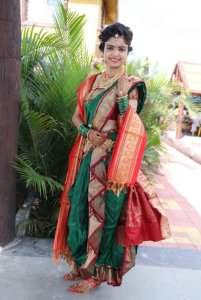
Image – Source
The Lugda is a traditional attire worn by tribal women, particularly from the Bhil and Gond communities in Madhya Pradesh.
This simple yet elegant garment is similar to a saree but typically made of coarser, handwoven fabric.
The Lugda is often paired with a matching blouse and worn in a draped style, allowing freedom of movement for women working in rural areas.
The tribal designs on the Lugda often feature vibrant colors and patterns reflecting nature. It holds cultural significance, especially during tribal festivals and ceremonies.
Despite modern influences, the Lugda continues to be a symbol of tribal heritage and identity in Madhya Pradesh.
Lugda Dress Details
| Dress Feature | Details (Female) |
| Dress Name | Lugda |
| Primary Fabrics | Coarse handwoven cotton |
| Regional Variations | Worn predominantly by Bhil and Gond tribes |
| Typical Colors | Earthy tones with vibrant tribal patterns |
| Ornamentation | Simple, nature-inspired motifs |
| Special Occasions | Worn during tribal festivals, harvest celebrations, and rituals |
| Jewelry & Accessories | Often paired with beaded jewelry, bangles, and anklets |
| Cultural Symbolism | Represents tribal identity and heritage |
| Seasonal Adaptation | Cotton versions for summer; thicker fabric for cooler months |
| Craftsmanship | Handwoven by tribal artisans |
| Influence of Royalty | Limited influence of royalty; more tied to tribal customs |
| Modern Adaptations | Occasionally adapted into modern tribal-inspired fashion |
| Functionality | Provides comfort and flexibility for daily wear, especially in rural areas |
6. Dhoti – The Timeless Garment for Men
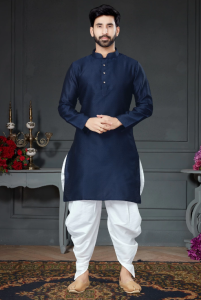
Image – Source
The Dhoti is one of the oldest traditional garments for men in Madhya Pradesh and is still widely worn in rural areas.
This unstitched piece of cloth is wrapped around the waist and legs, offering both comfort and ease of movement.
Men often wear dhotis during cultural festivals, weddings, and religious ceremonies, as it remains a symbol of tradition and simplicity.
Though dhotis are commonly worn in white, they can also be found in different shades with thin borders or minimal patterns.
Lightweight and breathable, the dhoti is well-suited to Madhya Pradesh’s warm climate, particularly during the summer months.
Dhoti Dress Details
| Dress Feature | Details (Male) |
| Dress Name | Dhoti |
| Primary Fabrics | Cotton |
| Regional Variations | Common across all regions of Madhya Pradesh |
| Typical Colors | White or beige with minimal border embellishments |
| Ornamentation | Rare, though sometimes features small decorative borders |
| Special Occasions | Commonly worn at weddings, religious festivals, and cultural events |
| Jewelry & Accessories | Paired with a Safa (turban) or simple ornaments |
| Cultural Symbolism | Represents simplicity, tradition, and spiritual purity |
| Seasonal Adaptation | Ideal for summer due to its breathable fabric |
| Craftsmanship | Typically handwoven cotton |
| Influence of Royalty | Limited; mostly worn by rural men and as part of ceremonial dress |
| Modern Adaptations | Occasionally worn with modern upper garments for special occasions |
| Functionality | Comfortable and practical for both daily use and formal events |
7. Safa – The Turban Symbolizing Pride
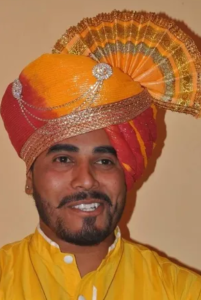
Image – Source
The Safa is a traditional turban worn by men in Madhya Pradesh. It symbolizes pride, honor, and respect and is especially popular during special occasions such as weddings, religious festivals, and political ceremonies.
The Safa is wrapped intricately around the head, often using brightly colored cloth to make a bold statement.
This traditional headgear varies in style and color across regions of Madhya Pradesh, but its symbolic importance remains constant.
It is an essential part of men’s traditional attire, adding a dignified touch to outfits like the dhoti or kurta.
Safa Dress Details
| Dress Feature | Details (Male) |
| Dress Name | Safa (Turban) |
| Primary Fabrics | Cotton, silk, or blended fabrics |
| Regional Variations | Various styles across regions like Malwa and Bundelkhand |
| Typical Colors | Bright colors like red, orange, yellow |
| Ornamentation | Occasionally features embroidered or brocade borders |
| Special Occasions | Worn during weddings, political events, and religious festivals |
| Jewelry & Accessories | Often worn with traditional outfits like dhoti or kurta |
| Cultural Symbolism | Symbol of pride, respect, and honor |
| Seasonal Adaptation | Lightweight fabrics for summer; thicker fabrics for winter |
| Craftsmanship | Handcrafted and tailored specifically for individual use |
| Influence of Royalty | Influenced by royal families who wore ornate versions of the turban |
| Modern Adaptations | More modern fabrics and styles are used in contemporary versions |
| Functionality | Adds a formal and dignified touch to traditional attire |
8. Mirzai and Bandi – Classic Jackets for Men
The Mirzai and Bandi are traditional jackets worn by men in the regions of Malwa and Bundelkhand. These short jackets are typically made of either cotton or wool, providing warmth during the colder months.
The Mirzai is a longer jacket with a more formal look, while the Bandi is a shorter, sleeveless option. These garments are usually worn over a dhoti or kurta, adding a sophisticated layer to the traditional male attire.
While the designs of these jackets may be simple, they are often adorned with subtle patterns or embroidery, making them suitable for festive occasions or religious ceremonies.
Even in modern times, the Mirzai and Bandi continue to be popular among men in rural Madhya Pradesh, symbolizing cultural pride and tradition.
Mirzai and Bandi Dress Details
| Dress Feature | Details (Male) |
| Dress Name | Mirzai and Bandi |
| Primary Fabrics | Cotton, wool |
| Regional Variations | Predominantly worn in Malwa and Bundelkhand |
| Typical Colors | Black, white, and sometimes vibrant colors for festivals |
| Ornamentation | Simple embroidery or decorative borders |
| Special Occasions | Worn during religious ceremonies, weddings, and winter months |
| Jewelry & Accessories | Often paired with a turban or Safa |
| Cultural Symbolism | Represents cultural identity and tradition |
| Seasonal Adaptation | Wool variants for winter; cotton for warmer climates |
| Craftsmanship | Handwoven and tailored by local artisans |
| Influence of Royalty | Minimal; mostly a rural and practical garment |
| Modern Adaptations | Occasionally modernized with different cuts and fabrics |
| Functionality | Comfortable, practical for both formal and casual occasions |
9. Angarkha – Traditional Robe for Men
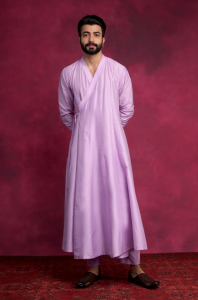
Image – Source
The Angarkha is a traditional robe-like garment worn by men in Madhya Pradesh, especially during special occasions and cultural festivals.
This attire, usually made from cotton or silk, is characterized by its long, flowing design and can be either plain or intricately embroidered.
The Angarkha is tied at the side, offering both comfort and a regal appearance, making it a preferred garment for ceremonial wear.
Its historical significance lies in its association with royalty and nobility, but even today, it is worn by men of all ages during religious festivals, weddings, and cultural gatherings.
The Angarkha symbolizes dignity and tradition, making it a timeless part of Madhya Pradesh’s traditional attire.
Angarkha Dress Details
| Dress Feature | Details (Male) |
| Dress Name | Angarkha |
| Primary Fabrics | Cotton, silk |
| Regional Variations | Worn across Madhya Pradesh, with slight variations in style |
| Typical Colors | Bright colors like red, maroon, and yellow |
| Ornamentation | Embroidery, mirror work, and zari designs |
| Special Occasions | Popular during weddings, religious ceremonies, and cultural festivals |
| Jewelry & Accessories | Often worn with traditional jewelry like necklaces or paired with a Safa |
| Cultural Symbolism | Represents nobility, respect, and cultural heritage |
| Seasonal Adaptation | Lightweight fabrics for summer; heavier fabrics for winter |
| Craftsmanship | Handwoven and tailored by skilled artisans |
| Influence of Royalty | Traditionally worn by royalty and nobles |
| Modern Adaptations | Modern cuts and fabric choices have influenced its contemporary versions |
| Functionality | Provides a regal appearance while being comfortable and practical |
10. Jawar Coat – A Traditional Male Attire

Image – Source
The Jawar Coat is a traditional outer garment worn by men, especially in rural Madhya Pradesh.
Made from durable fabrics like wool or cotton, it provides both comfort and functionality, making it ideal for cooler weather.
Its simple, long design often features minimal decoration, but some may have subtle embroidery or patterned borders to add cultural flair.
This coat is typically worn over a Kurta or Angarkha and pairs well with the Dhoti or trousers.
The Jawar Coat remains popular for everyday wear in rural areas and during special ceremonies in colder seasons, symbolizing practicality while staying rooted in cultural tradition.
Jawar Coat Dress Details
| Dress Feature | Details (Male) |
| Dress Name | Jawar Coat |
| Primary Fabrics | Wool, cotton |
| Regional Variations | Worn across rural Madhya Pradesh |
| Typical Colors | Earth tones like brown, beige, and dark green |
| Ornamentation | Minimal; occasionally with embroidered borders |
| Special Occasions | Ideal for winter ceremonies, rural functions, and daily wear |
| Jewelry & Accessories | Paired with traditional outfits like Dhoti and Kurta |
| Cultural Symbolism | Represents functionality and practicality |
| Seasonal Adaptation | Wool variants for winter; lighter cotton for transitional weather |
| Craftsmanship | Locally tailored and handwoven by rural artisans |
| Influence of Royalty | Minimal; mostly a practical garment worn by rural men |
| Modern Adaptations | Contemporary styles feature newer fabrics and cuts |
| Functionality | Provides warmth and ease of movement, ideal for daily use and cultural events |
Conclusion
The traditional attire of Madhya Pradesh is a true celebration of the state’s heritage and artistic diversity.
Whether it’s the graceful Maheshwari sarees worn by women or the stately Angarkha donned by men, each garment represents the values, traditions, and craftsmanship passed down through generations.
These dresses, deeply rooted in regional history and culture, continue to be worn with pride during important occasions.
Despite the influence of modernization, Madhya Pradesh’s people continue to embrace their traditional clothing, preserving the essence of their cultural identity.
Through their vibrant fabrics, detailed embroidery, and symbolic designs, the state’s traditional dresses remain a living testament to the artistry and cultural legacy of Madhya Pradesh.
FAQs About Madhya Pradesh Dress
What are the most popular traditional dresses for women in Madhya Pradesh?
The most popular dresses for women in Madhya Pradesh include Lehenga-Choli, Bandhani Sarees, Chanderi, and Maheshwari sarees, worn during festivals and weddings.
Which sarees are famous in Madhya Pradesh?
Chanderi and Maheshwari sarees are the most famous, known for their fine handwoven fabrics and intricate designs that are highly sought after.
What is the significance of Safa for men in Madhya Pradesh?
The Safa (turban) symbolizes pride, honor, and dignity and is worn during weddings, festivals, and religious ceremonies by men across the state.
What is the traditional dress of tribal women in Madhya Pradesh?
Tribal women, particularly from Bhil and Gond communities, wear the Lugda, a simple draped garment, often paired with tribal jewelry.
Which regions of Madhya Pradesh are known for specific traditional dresses?
Chanderi sarees originate from Chanderi, and Maheshwari sarees from Maheshwar. Tribal dresses like Lugda are common in regions inhabited by Bhils and Gonds.
How is the Bandhani saree made?
Bandhani sarees are created using a tie-dye technique, where parts of the fabric are tightly tied before dyeing to produce intricate patterns.
What is the modern relevance of traditional dresses in Madhya Pradesh?
Traditional dresses remain relevant for cultural events, and modern adaptations have made them versatile for festive and formal occasions while preserving heritage.





